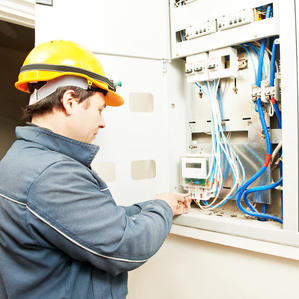Section 11 - Electrical
11.A General.
11.A.01 Approval and qualification.
The term "Qualified Person (QP)", as used in this section, refers to "Qualified Person, Electrical". > See Appendix Q.

- All electrical wiring and equipment must be a type listed by a nationally recognized testing laboratory for the specific application for which it is to be used.
- All electrical work must comply with applicable National Electrical Safety Code (NESC), National Electric Code (NEC), National Fire Protection Association (NFPA), OSHA and USCG regulations. If the work being performed (as described within this chapter) conflicts with the above codes and regulations, the most stringent must apply.
- Electrical work must be performed by QP with verifiable credentials who are familiar with applicable code requirements. Verifiable credentials consist of State, National and/or Local Certifications or Licenses that a Master or Journeyman Electrician may hold, depending on work being performed, and should be identified in the appropriate AHA. Journeyman/Apprentice ratio must be in accordance with State, Local and Host Nation requirements applicable to where work is being performed.
- USACE and/or other Government designated QPs must possess verifiable credentials and must be familiar with applicable code requirements. Verifiable credentials consist of State, National and/or Local Certifications/Licenses that a Master or Journeyman Electrician may hold, or USACE-sponsored local training programs (e.g., hydropower training program, District navigation training program, etc.) but the following applies:
- Training must be provided by an electrically qualified source to the level of work being performed;
- Training and qualifications must be verifiable and documented;
- Qualification level must be identified in the employee's PHA;
- QPs must demonstrate skills and knowledge related to the construction, operation and maintenance of the electrical equipment and installations and receive relevant safety training to recognize, avoid and control associated hazards.
- Emergency Procedures and training. Employees exposed to shock hazard and those employees responsible for taking action in case of emergency must be trained in methods of release of victims from contact with exposed energized electrical conductors or circuit parts. Employees must be regularly instructed in methods of first aid and emergency procedures, such as approved methods of resuscitation, if their duties warrant such training. Training and re-training of employees in approved methods of resuscitation, including cardiopulmonary resuscitation and automatic external defibrillator (AED) use, must be certified by the employer as required by Section 03.A and OSHA 29 CFR 1910.151 and NFPA 70E 110.2(c).
11.A.02 Isolation.
- Before work begins, a Qualified Person in charge must ascertain by inquiry, direct observation and by instruments, whether any part of an electric power circuit (exposed or concealed) is located such that the performance of work could bring any person, tool, or machine into physical or electrical contact with it. This verification procedure must be documented prior to work beginning.
- All equipment and circuits to be worked on must be de-energized before work is started. Personnel must be protected by a Hazardous Energy Control Program (HECP) and procedures (i.e. lockout/tagout, blanking, positive means of blocking, grounding, etc.). Positive means must be provided for rendering controls or devices inoperative while repairs or adjustments are being made to the machines they control. > See Section 12.
- Note: If work MUST be performed on an energized system, then the employer must first demonstrate that de-energizing introduces additional or increased hazards (i.e., interruption of life support equipment, removal of light for an area, etc.) or is infeasible due to equipment design or operational limitations (i.e., testing, troubleshooting, etc.).
- Energized work may never be performed without prior authorization. Once it has been determined that equipment must be worked on in an energized condition, an energized work permit must be submitted to GDA for acceptance. > See NFPA 70E. Permits must be prepared in advance and include, as a minimum:
- (1) Description of work and location;
- (2) Justification for why the work must be performed in an energized condition;
- (3) Description of work practices to be followed;
- (4) An electrical shock analysis and boundaries (safe working distances);
- (5) Arc flash hazard analysis and arc flash boundary determination;
- (6) Identification of PPE necessary to safely perform the task;
- (7) Means to restrict access of unqualified persons in work area;
- (8) Evidence of completing the job briefing (includes safety, tools, PPE, any other hazards and controls).
- Live parts of wiring or equipment must be guarded to protect all persons or objects from harm.
- High voltage equipment (i.e., switchyards, transformers, etc) must be protected from unauthorized access. Entrances not under constant observation must be kept locked; metallic enclosures must be grounded and signs warning of high voltage and prohibiting unauthorized entrance must be posted at entrances.
- Enclosure gates or doors must swing outward or provide clearance from installed equipment.
11.A.03 When it is necessary to work on energized lines or equipment, rubber gloves and other protective equipment and hotline tools meeting the provisions of ANSI and ASTM standards must be used. For work on energized equipment, only tools insulated for the rated voltage must be used. > See Section 05.I and NFPA 70E.
Knowledge Check Choose the best answer for the question.
11-1. What must be completed before energized electrical work is performed?
You forgot to answer the question!
